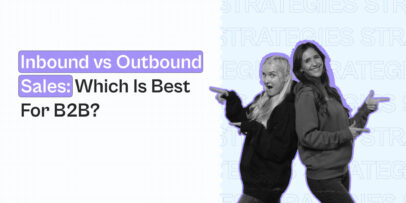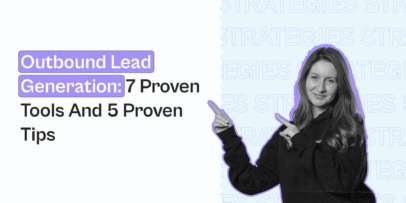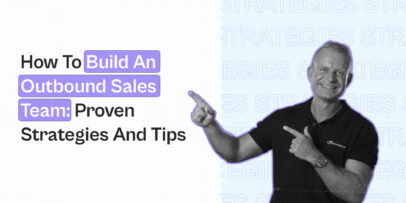ICP in Business: How to Use Ideal Customer Profile & Buyer Personas in Sales Outreach

Need to streamline your outreach efforts and convert leads at scale? Defining an ICP and converting it to a potent prospects list is your first stepping stone to success.
If that sounds like a lot of work to get started, we’re here to help you.
In this article, you will learn ICP meaning in business, the importance of building an ICP in business, and actionable steps to convert your ICP and buyer personas into a prospects list ready-made for sales outreach.
What is ICP and buyer persona?
Everyone is not your target customer. Understanding who exactly you’re selling to can help you position your offer better and close more deals. And that’s when creating an ICP and a buyer persona step in.
An ICP – ideal customer profile, is a hypothetical description of THE perfect customer and their characteristics who may find your products or services super valuable for their use cases.
ICP in marketing and B2B sales offers guidance to understand if the customer is a good fit and is worth pursuing. ICP typically describes a type of company as your ideal customer. For example, a restaurant in Florida with annual revenue of up to $500k and about 20 employees.
On the other hand, the buyer persona is a semi-fictional representation of your dream customers. It outlines your individual target customers’ goals, preferences, motivations, demographics, pain points, etc.
A buyer persona helps you identify a company’s exact customers, aka key decision-makers. For example, for the restaurant owner ICP, your buyer persona would be: John Smith – age 60, running a medium-sized restaurant in Florida. He is not tech-savvy and needs help modernizing his accounting system with the latest software.
Need help building a detailed ICP and buyer persona? Read our step-by-step guide to get started.
7 reasons why it’s important to create a buyer persona and ICP in business before cold outreach
Since we’ve established the ‘what’ of ICP and buyer persona, let’s understand their ‘why’s’:
1. Focus
In sales and marketing, time equals money. You’d rather prefer spending money on high-value accounts than mediocre ones. Building ICP helps you get started on the right note.
ICP lets your sales outreach teams laser focus only on high-value, persuasion-worthy prospects during the initial prospecting stage instead of wasting time engaging with wider audiences.
What’s more? By chasing a hyper-focused group using sales ICPs, you can spend lesser money and fewer resources while building strong relationships with valuable customers.
2. Finding relevant leads
An ICP filters out irrelevant market segments and lets your teams extract relevant leads who are capable of increasing your bottom-line revenue.
For example, using tools like the LinkedIn Sales Navigator, you can look for prospect profiles that fit your ICP. Just click ‘View Similar’ to uncover more similar profiles, find top decision-makers in each company based on your buyer persona, and finally, extract the details for outreach.
3. Lead segmentation
A list of chase-worthy leads does not give leeway to start with your outreach activities. Before reaching out to high-intent leads, segment them based on certain common criteria to customize your outreach campaigns.
Because let’s face it, it’s easier to curate messaging and sell to prospects in the same boat.
Say your buyer personas are gym owners, and you have a list of gym owners from a certain area. Segment them further into smaller groups based on criteria such as annual revenue, number of customers, business stage, needs, etc.
Lead segmentation allows you to create hyper-targeted, personalized cold email outreach or Linkedin outreach campaigns. Further, if you have more than one ICP or buyer persona, creating separate segmented outreach campaigns helps you compare campaigns that outperformed the rest.
4. Choosing the right channel
Thanks to digital domination, audiences now prefer different channels to communicate and engage with brands.
ICP and buyer personas help you uncover what channels your prospects hang out in. For example, most B2B customers hang around LinkedIn for networking and prefer emails over calls for communication.
However, remember that your ideal prospects’ digital channel preferences are prone to change. So ensure you A/B test multiple channels frequently to catch changes early on.
5. Personalization
Think about it. Right from the point of outreach emails to discovery calls and closing the sale, you communicate with prospects through various mediums.
So how can your sales approaches stand out and make prospects’ interaction with you an unforgettable experience? One word – personalization.
What’s more? The right personalization can:
- Help you break through the competitor noise and stand out with your tailored messaging, unique brand tone, etc.
- Humanize your cold outreach by adding personal elements to communication instead of blanket, generic pitches. Adding a human touch increases the chance of getting a response as prospects feel more connected.
- Foster meaningful conversations that lead to sales and build a strong foundation of trust between both parties.
Cold outreach emails and messages, pitch decks, sales calls – you name it, can be personalized to win prospects’ trust.
But how can you start personalizing communication?
Refer to your buyer personas to check for your ICP’s preferred communication style, interests, demographics, etc. Next, you can add personal elements to every piece of communication, for example, a custom opening line in a welcome email, a congratulatory line in a LinkedIn DM, etc.
Here’s an example of a personalized LinkedIn message for a hot lead:
“Hey {first_name},
Congratulations on winning {event_name}! An event at this scale ain’t easy to win.
I recently came across your post on how your restaurant business could use new accounting software.
Our company – {company_name} has helped many small businesses like yours.
If you’re interested, we could catch up over a quick call.
Let me know if I can send over a few times to chat!”
6. Defining qualification criteria
ICP and buyer personas lay out the path for sales reps to determine criteria for marketing qualification (MQLs) and sales qualification (SQLs) of leads.
They also help you identify who can be moved to which successive stage in your sales pipeline.
Why does it matter?
Sometimes, interested leads may not be ready to close the sale yet. So you can move them to a nurturing sequence until they change their minds.
While pursuing your outreach efforts, don’t forget to backtrack and check the quality of leads you’ve generated so far. An increase in low-value leads may need you to revamp your ICP and buyer personas.
7. Better performance
The more well-researched your ICP and buyer personas, the better your sales outreach campaign performance. This is a no-brainer, as both ICP and BPs extract prospects who perfectly align with your company’s products or services – improving your overall conversation and success rate.
How to convert ICP to the prospects list for outreach – with use cases
It’s now time to convert your ICP into a ready-to-go prospects list with the LinkedIn Sales Navigator and Expandi. Here are five steps to supercharge your outreach efforts:
Step 1: Convert general target customer info into Sales Navigator filters
Extract your ideal customer’s general details, such as location, industry, company size, job title, etc. Next, convert these details into Sales Navigator’s advanced filters to quickly filter out the needed data.
Here’s an initial message you can send to target customers on LinkedIn once you’ve filtered them based on some general criteria:
“Hey {first_name},
Noticed you’re also from Downtown Denver. I’ve done most of my schooling there.
Would be awesome to connect with a fellow Coloradan. Let me know if we can chat over a virtual coffee this Friday?
Best,
{your name}”
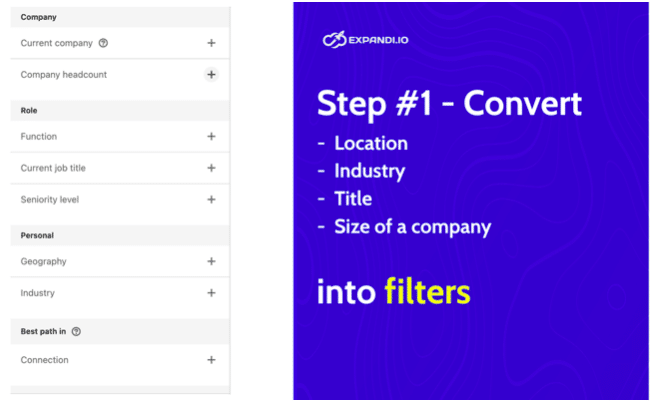
Step 2: Convert “business pain points/challenges” into the SN filters
Since you already have your ICP’s main pain points and challenges they face (refer to your buyer personas), build your prospects list based on these filters to ensure zero wasted outreach efforts.
Convert the ICP’s biggest pain points and challenges into LinkedIn Sales Navigator’s filters.
For example, say your product targets top sales executives and decision-makers. You can select the advanced filter “Changed jobs recently” to target a VP of Sales recently promoted. Why? A recently promoted person is more likely to be willing to transform their current sales processes and has the authority to do so.
Here’s a sample LinkedIn message you could send them:
“Hey {first_name},
Saw that you recently got promoted to the VP of Sales at {company} – big congrats on that. It’s not an easy feet!
I spoke to a VP of Sales at a Fortune 500 company last week who had the same profile as yours. We are currently helping them upgrade their internal sales processes.
And your recent posts highlighted you’ve been on the lookout for similar solutions.
Would you mind catching up over a quick meeting to see if we could collaborate and if our solutions fit your business objectives.
Best,
{your name}”
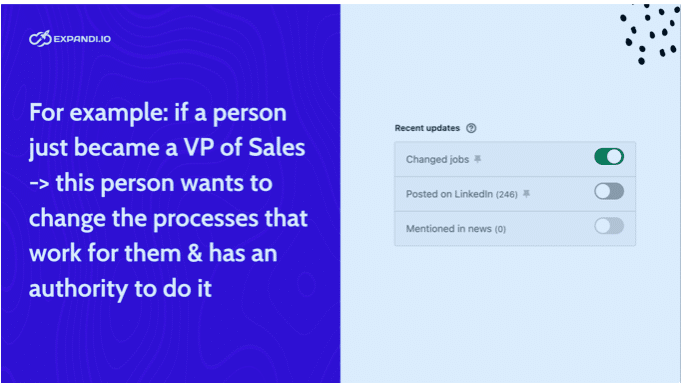
Step 3: Convert “Interests” into good personalization
There’s no better personalization than shared interests. Building prospects lists based on your ICP’s ‘interests’ lets you personalize outreach communication and get into their good books.
Is your ideal customer part of a LinkedIn group you belong to? Or did they attend the same school as you? Get creative in extracting information so your messages are as personalized as possible to build an immediate rapport.
Imagine the target customer is part of a LinkedIn group called ‘SaaS Founders Hub – London.’ This indicates their interest in connecting with local SaaS founders and building connections.
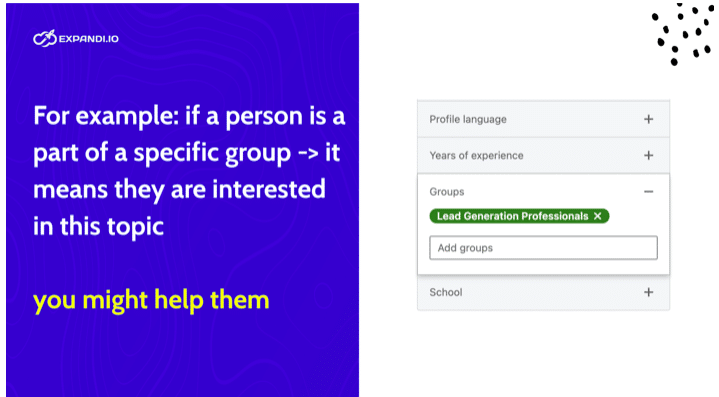
Now, how can you filter them and personalize the introductory emails? Using the LinkedIn Sales Navigator alongside an intuitive sales automation tool like Expandi.
Mini-tutorial #1: Building a prospects list based on shared LinkedIn groups and scraping them to send personalized introductory emails:
- Firstly, start filtering prospects based on interests – in our case, specific LinkedIn groups, company type, etc., depending on your buyer persona:
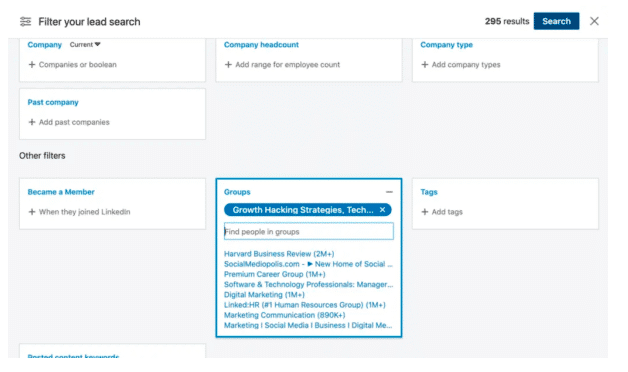
- Sign in to Expandi to start scraping the chosen LinkedIn group. Select the ‘Campaign’ tab and choose ‘Group campaign.’ Add a campaign instance (name and details.)
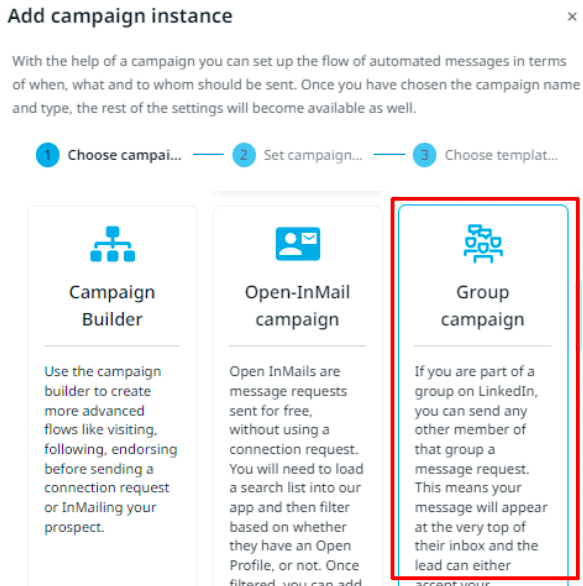
- Link a specific LinkedIn group to select and scrape targeted members. Before that, ensure you’re already a member of the group.
- Start building your personalized message sequence to be sent to each prospect.
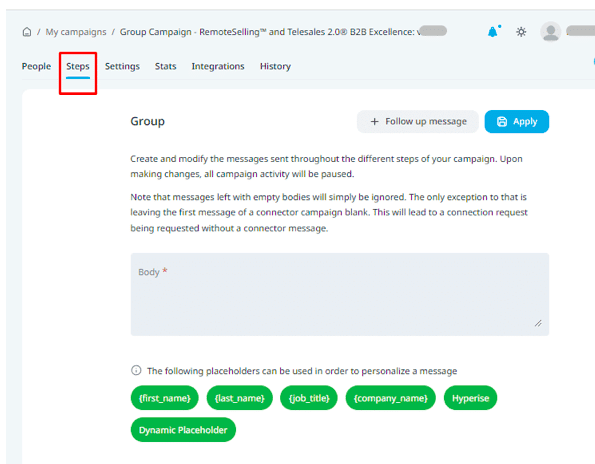
- Finally, combine LinkedIn outreach with email using Expandi’s Smart Sequences for an all-around outreach mechanism.
A personalized email and LinkedIn message (follow-up) could look like this:
Hey [first_name],
We are both part of the SaaS Founders – London group on LinkedIn! It’s hard to find active folks in our network.
Would you like to catch up over a quick virtual coffee tomo? Let me know if you’re free to chat, and I can send over a few times.
Thanks,
[your name]
LinkedIn follow-up message:
“Hey {first_name},
I recently dropped you an email and I guess got lost in your crowded inbox.
I’d noticed we’re both part of the SaaS founders – London group on LinkedIn. So it would be lovely to meet like-minded local folks like yourself.
Would be lovely if we could catch up over a virtual (or a real) coffee sometime this week. Looking forward to talking to you!
Best,
{your name}”
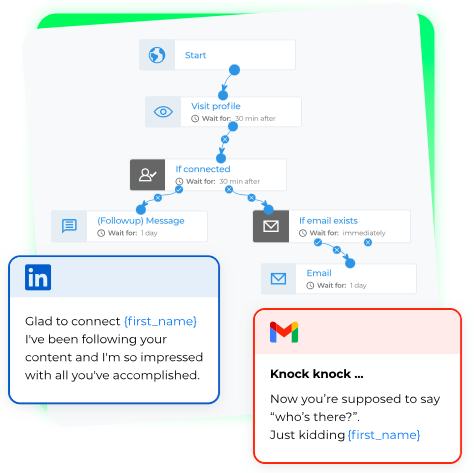
Mini-tutorial #2: Building a prospects list based on ideal customers’ interests in certain topics
How can you identify topics your ideal customers are interested in? Look for their recent interactions on others’ LinkedIn posts.
Here’s how to do this:
- Find a LinkedIn influencer with a large following in your domain and look for posts with high engagement (likes and comments).
For example, the below post by Stefan Smulders on LinkedIn:
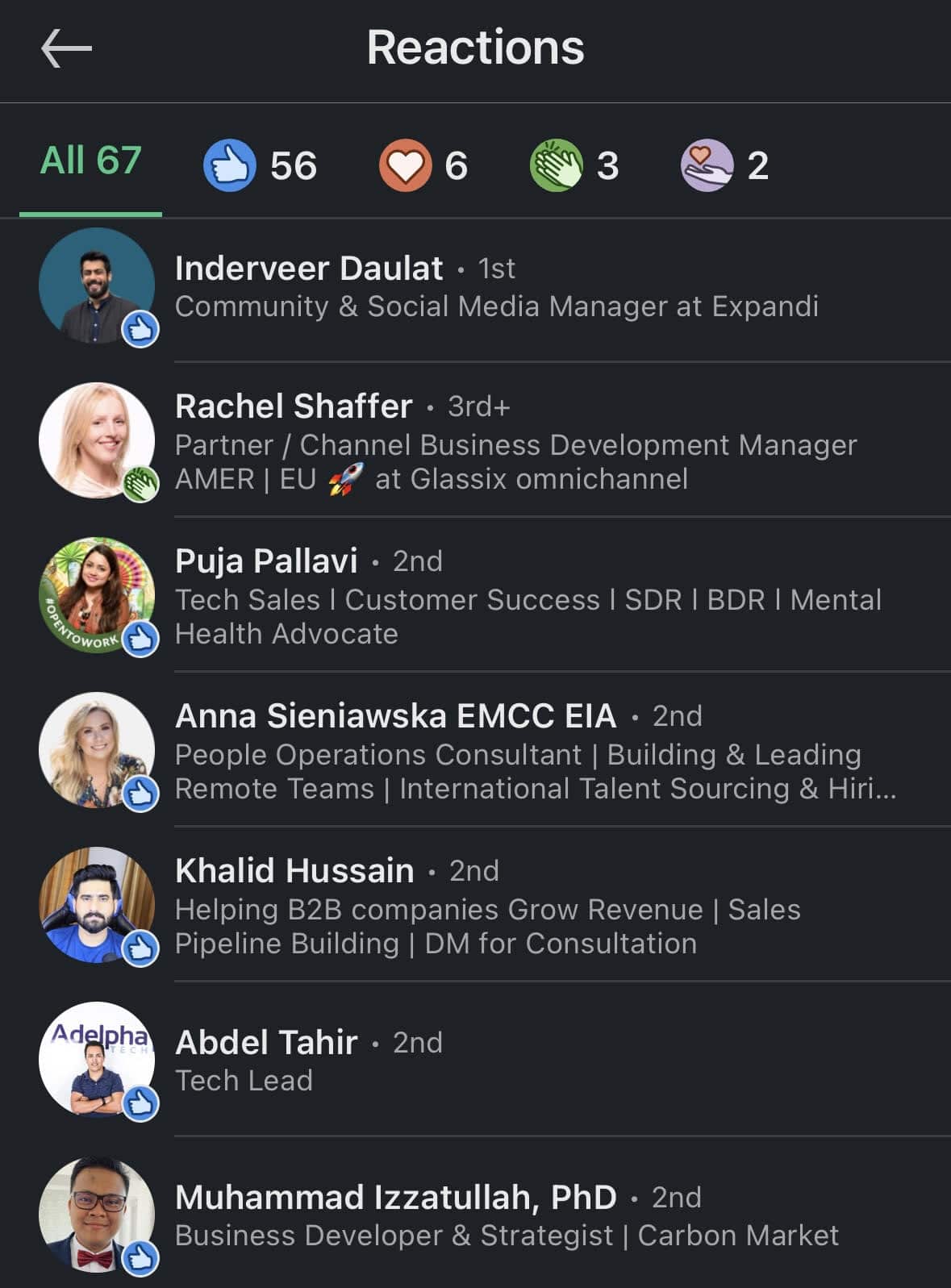
- Click on ‘Copy link to post.’

- Login to your Expandi account and head to the search menu on the left pane.
- Click on ‘Start new search’ and name your search.
- Choose ‘Post engagement’ and paste the copied link to the LinkedIn post. Enter a post ID to get started.
- Now, set up an automation campaign inside Expandi to send customized messages to your prospects interacting with the post.
Here’s an example to use:
Hey {first_name},
Saw you liked Stefan Smulders’ recent post on what bootstrapped founders must go through.
I recently spoke to a founder like yourself on this very topic!
Would you like to catch up over a quick virtual coffee and rant about it? Let me know!
Thanks,
{your name}
Step 4: Convert “Goals” into great personalization
Your prospects are people too. They have ambitions and goals they’d like to achieve and a sufficient budget to execute them by trying new methods to help their company get there.
Use this tactic to filter out prospects and build a powerful goal-oriented contacts list:
Filter based on department headcount (50 to 200% growth) to see if they’ve recently hired a ton of salespeople. That means they have enough budget to execute new methods and need new ‘team features’ to reach their business goals:
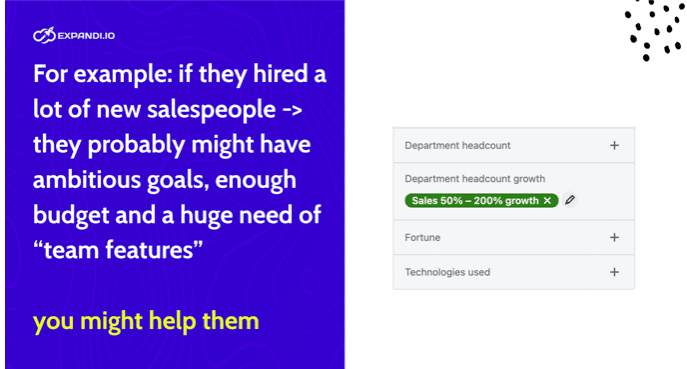
Here’s a LinkedIn message personalized based on a prospect’s goals:
“Hey {first_name},
Noticed you grew your sales team at {company_name} by over 100%. Congrats on such an incredible growth!
But as you know, a large team calls for revamped internal team processes to help your team efficiently move towards the company’s goals.
Lucky for you, our experts at {your company} has helped many teams in your industry see a spike in their sales team’s efficiency.
Would love to talk to you over the same. Can we catch up over a quick 10-minute call tomorrow?”
Step 5: Convert “Technologies” into great segmentation
Chasing prospects who do not use your solution’s in-house or supported technology is a waste of time, money, and sweat.
Pre-qualifying prospects by segmenting them into technologies they use and you integrate or support with your solution is a great way to shorten sales cycles.
How can you do this?
Using a tool like BuiltWith, you can perform advanced filtering based on prospective companies’ in-house technologies.
For example, let’s say you’re looking to work with decision-makers of companies (in the U.S.) using Zoho CRM.
Head to BuiltWith and enter ‘Zoho CRM’ as the technology/tool and select US websites from the drop-down. You instantly receive a list of top websites having the tool on their homepage:
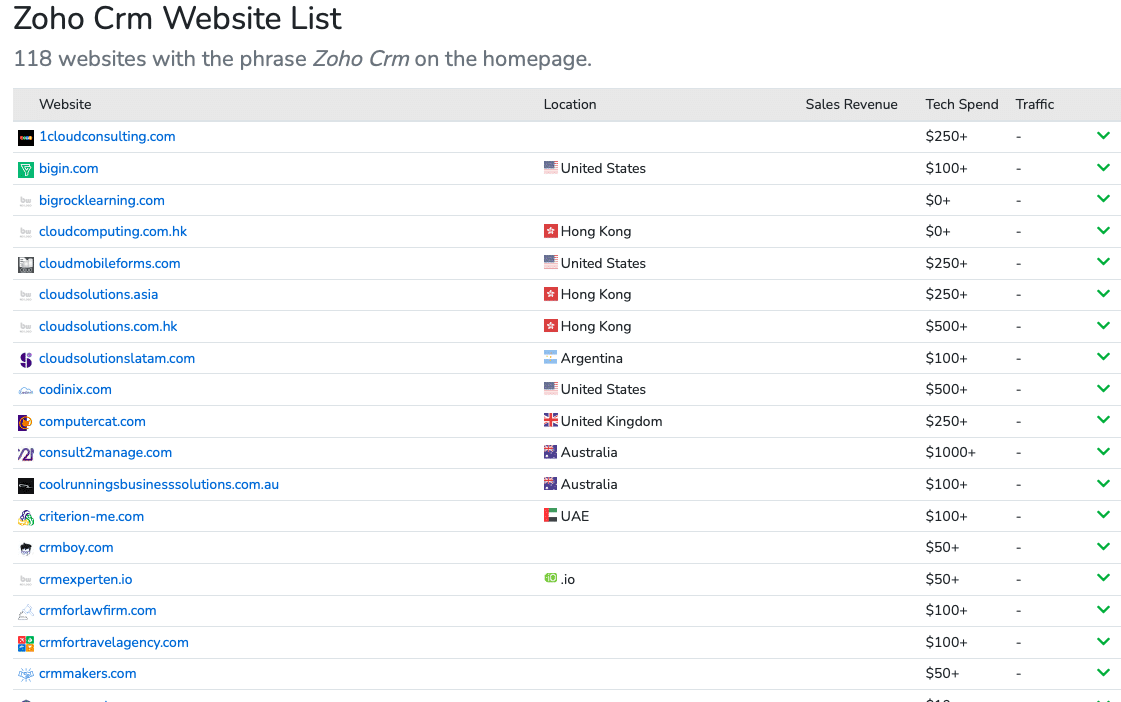
And when you expand the row under the desired lead, BuiltWith offers an easy way to find people from the company on LinkedIn so that you can carry out your outreach efforts:
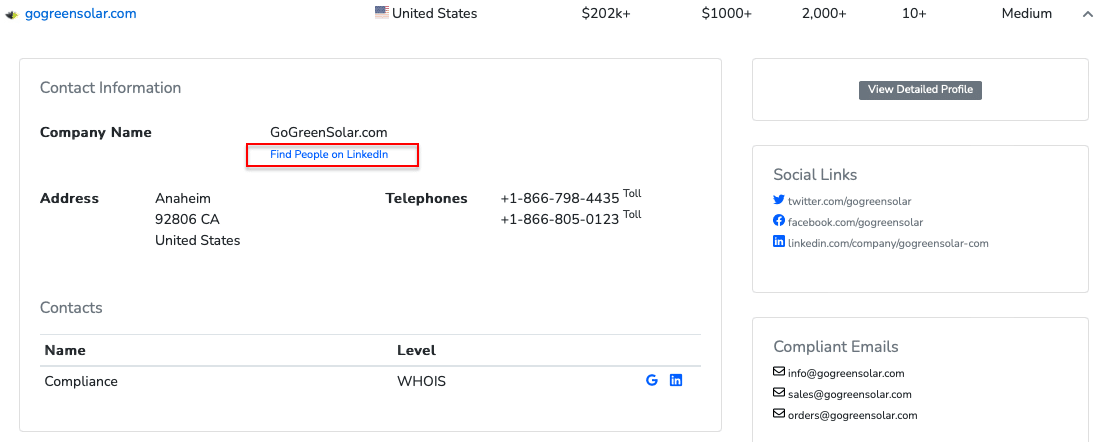
You can further drill down potential companies based on their tech spending, website traffic, sales revenue, and more.
Here’s a sample personalized outreach message highlighting the company’s tech stack:
“Hi {first_name},
Saw that {company_name} leverages Zoho CRM to manage sales ops and optimize customer experiences. It’s undoubtedly a powerful tool to manage and cut costs.
But did you know a more streamlined approach can cut more costs and amplify Zoho CRM’s benefits?
Would be glad to explain more on this and see if there’s a possibility of a successful collaboration.
Thanks,
{your name}”
Conclusion
Building a valuable prospects list out of ICP and buyer personas take much trial and error.
But getting the basics right, such as understanding who to reach out to and what makes a prospect ‘hot,’ and who is chase-worthy, helps you build a robust sales engine using simple platforms like LinkedIn and email. And not to forget the tremendous time and energy it saves.
A sales automation tool like Expandi fuels your ‘sales and outreach’ engine.
Try Expandi’s 7-day free trial and watch your prospects list change into high-intent leads!
You’ve made it all the way down here, take the final step
